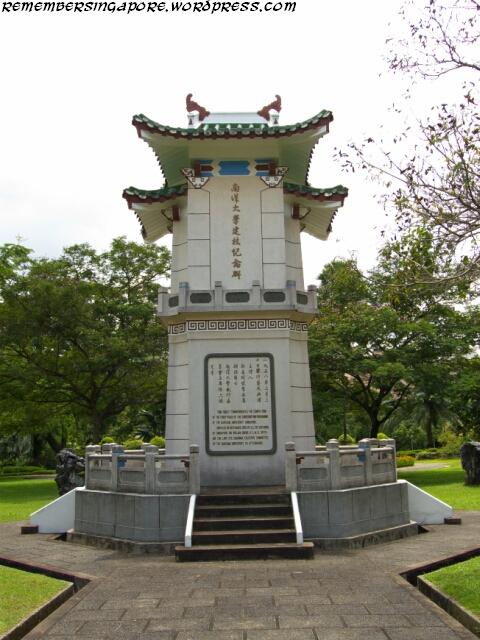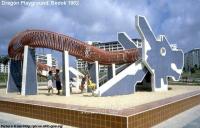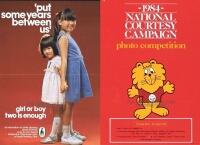There are two Nanyang University (or Nantah) Archs in Singapore, one original and one replica. The original one stands at present-day Jurong West Street 93, while the replica arch is located inside the Yunnan Garden of Nanyang Technological University.
In the old days, the cars and buses would pass through the original arch from the Old Upper Jurong Road to Nanyang University. The arch was never shifted, but the landscape around it had changed greatly.

The four big characters “南洋大学” (Nanyang University) on the original arch was written by cursive script calligraphy expert Yu Youren (于右任) (1879-1964). The year 1955 represented the year when the pre-university classes were started for students to prepare for their entry to the new university. A year later in March 1956, the first batch of 584 students was admitted to Science, Commerce and Arts faculties.

The Chinese community yearned for a higher education centre after the Second World War. In 1953, prominent businessman and chairman of Singapore Hokkien Association Tan Lark Sye (陈六使) (1897-1975) proposed to build a university. His proposal was echoed by Lee Kong Chian (李光前) (1893-1967), top rubber magnate and one of the richest Chinese in the world during his time.
The Hokkien Association donated 523 acres of land in western Jurong, while Chinese of all trades in Singapore and even other parts of Southeast Asia rallied in the monetary donations. Ordinary folks showed cohesiveness in their supports, with 1770 trishaw riders and nightclub hostesses donating a day of their incomes to the noble cause. Tan Lark Sye himself gave a generous donation of $5 million. (He was later buried at Bukit Brown Cemetery after his death)

It was a tough period when the university was first set up. The British colonial government was not supportive of the idea, and the university was not even allowed to register its name under the educational category. In the end, it had to be registered as Nanyang University Private Limited.
 The logo of Nantah consisted of three colour bands and a yellow star. The star represented the university itself, while the three circles stand for the three main races of Singapore: Chinese, Malay and Indians. They also signify the unity of the people, as well as the progress and productivity of a nation.
The logo of Nantah consisted of three colour bands and a yellow star. The star represented the university itself, while the three circles stand for the three main races of Singapore: Chinese, Malay and Indians. They also signify the unity of the people, as well as the progress and productivity of a nation.

Nanyang University accepted its first enrolment of students of different races in 1975.
In 1977, former Prime Minister Lee Kuan Yew proposed the restructuring of Nanyang University, citing the need for an English-language mainstream. Employers were beginning to shun Chinese-educated graduates which was an increasingly worrying trend in the society.
Three years later, Nanyang University was merged with University of Singapore to become National University of Singapore (NUS). There were also widespread suspicions that the move had political reasons as the government wanted to stamp out the communist ideas that were growing in the campus for the past decade.

With the closure of Nanyang University, a technical institute took over its campus in 1981 and was named Nanyang Technological Institute (NTI). It not was not until ten years later in 1991 before the institute was upgraded to become Singapore’s second English university in Nanyang Technological University (NTU).
In late nineties, there were calls and appeals to restore the name of NTU back to Nanyang University, including prominent late calligrapher and poet Pan Shou, but the move never materialised.

Consisting a library and a museum, the Chinese Heritage Centre in NTU was founded in 1995 to provide knowledge and studies of ethnic Chinese communities around the world.
It was previously an administrative building and library for Nantah, and was built together with the university in 1955.

Published: 10 November 2011
Updated: 25 December 2019








Nantah Arch bearing the name of Nanyang Technological Institute. c1980s
(Source: http://gallery.ntu.edu.sg/photos/main.php?g2_itemId=223)
An aerial view of Nanyang University in March 1959.
It was the first phase of its completion and thousands of guests were invited to the commemorative event, causing huge traffic jams at Jurong Road.
(Photo Credit: Chronicle of Singapore: Fifty Years of Headline News 1959-2009)
The crest of Nanyang University
(Source: http://blog.omy.sg/sgstory/archives/1126)
Now I know what does NTI means.Always heard people saying they are staying at jurong west NTI.
there’s a typo. It should be “ethnic” chinese instead of “ethic” chinese
Stores at Nantah in the 1980s
(Photo credit: Alison Emery of Facebook Group “Nostalgic Singapore”)
Since some Singaporeans recall this Nantah Graduate to help an Indonesian President look like ME,Mdm Chew from Ipoh, the invisible spirits from your Nantah Hostels came into my New York City including the Ipoh dark clouds and floods of Nostalgic days of childhood and School.
I guess my husband, mr cheah and I, Mdm Chew have still to be seen together in bed, since married in 1979.
He still likes me when he sent his messenger.
Heritage of Yunnan Garden ‘spans globe’
The Straits Times
04 March 2016
Largely deserted today, Yunnan Garden is a heritage gem in Nanyang Technological University’s (NTU) Jurong campus.
It is home to national monuments such as the library and administration building of the former Nanyang University, or Nantah. The building, now the Chinese Heritage Centre, was designed in the Chinese national style by local architect Ng Keng Siang, who is also behind the Lim Bo Seng Memorial at the Esplanade Park.
The building was gazetted in 1998 with a memorial and Nantah’s original arched gateway. These were also built in the same Chinese national style, with reinforced concrete and stylised Chinese motifs.
While heritage experts welcome news that NTU is planning to make the Yunnan Garden area more accessible for the public to enjoy, they said redevelopment must be sensitive to the Nanyang-style landscape.
Architectural historian Lai Chee Kien said: “When it was first designed, one could sense the grandness brought about by the formal symmetry of the garden and the former administration building after passing through the entrance archway.”
Dr Lai emphasised that the garden’s heritage is not limited to Singapore. “Singapore was chosen as the site of the first university for the region’s Chinese settlements so its heritage spans the globe as it involves the international Chinese community,” he said.
Founded in 1955, Nanyang University was built on a 200ha campus donated by the Hokkien Huay Kuan. Nantah closed in 1980 and NTU later occupied its grounds.
Likewise, architecture assistant professor Chen Yu said: “I hope that they will not treat it just as an open green space. Its landscaping with its memorial pagoda and pavilions was the venue for historical events.”
Among these events was Nantah’s first graduation ceremony in 1960.
Experts also pointed to features like the park’s terrazzo seats as representative of 1950s design, and the grass slope in front of the Chinese Heritage Centre bearing the Chinese saying: “To thrive in adversity, to strive and improve oneself constantly”. NTU said the redevelopment is to strengthen the heritage narrative of the campus, adding that the monuments will not be affected.
For Singapore Heritage Society’s executive committee member Yeo Kang Shua, plant selection is important. “For example, lush greenery will alter the aesthetic completely.
“The ensemble of historic elements such as its built structures, terrain, choice of plants, should be viewed as features of a historic landscape and therefore studied carefully by experts before any work to redefine the landscape starts.”
http://www.straitstimes.com/singapore/heritage-of-yunnan-garden-spans-globe